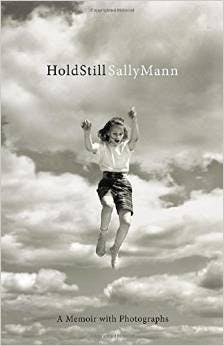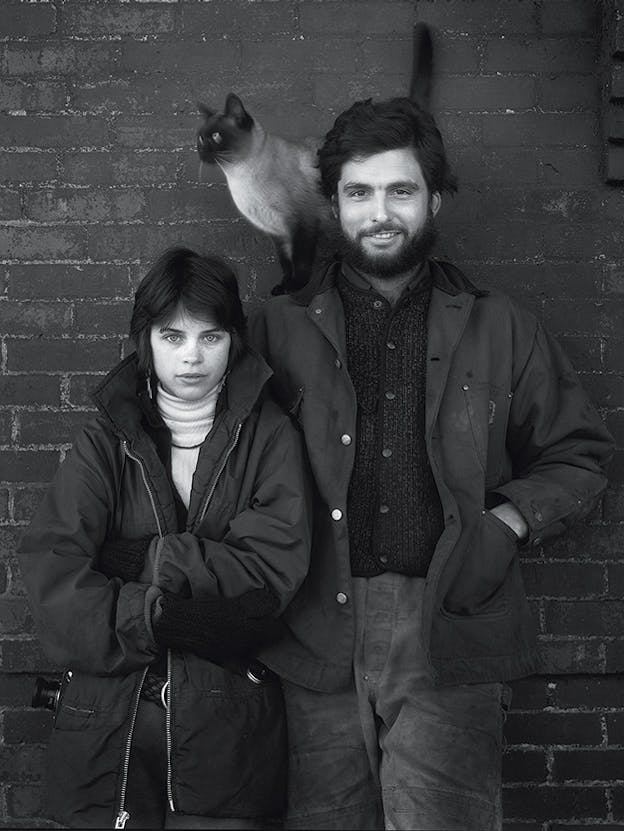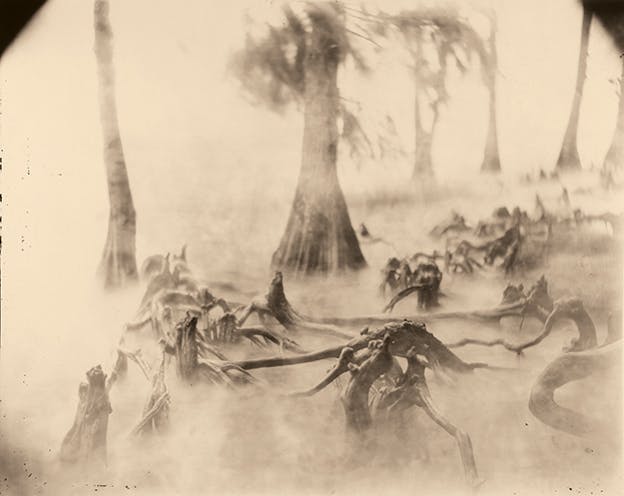Controversy has a logic of its own that tends to obscure the particulars of whatever caused the uproar; those caught in its shadow might recede for a time, only to be sucked back into its vortex the next time the debate is once again brought to the forefront of public consciousness.
So when discussing photographer Sally Mann it’s probably worth mentioning the nudity. Not just Irving Penn-style buttocks that might as well be musical instruments; not Richard Avedon’s cultural icons baring it all. Mann is known for nude images of her children. In some of the photos, the children stare back at the viewer confrontationally, while in others they are seemingly oblivious. In one particularly striking image, Mann’s daughter, Jessie, hangs from a hayhook in a barn, entirely naked, her head thrown back and her prepubescent mons pubis visible. It is arrestingly beautiful and also troubling, a difficult combination to turn away from.
Not surprisingly, Mann earned her spot in the controversy archives with the publication of the book that contained many of these images, Immediate Family (1992), although in the vast majority of the images, her children are clothed. Many people were not pleased that a mother, of all people, had willingly put these images out into the world. (“Was it really art, Ms. Mann, or was it covert incest?” one person wrote to her after seeing the pictures in The New York Times Magazine.) Photography is particularly susceptible to controversy; the photographer holds all the cards, while the subject can only hope for a good outcome, a power imbalance that often leads to accusations of exploitation. The person behind the lens claims something for herself that the subject might not have wanted to give.

In her new autobiography, Hold Still: A Memoir With Photographs, Mann says that it was never really all about the kids. It was about the place. “That’s the critical thing about the family pictures,” Mann writes, “they were only possible because of the farm, the place.” When, on the occasion of Mann’s fortieth wedding anniversary, her daughter credited “the farm” in Lexington, Virginia as a pillar of her parents’ marriage, Mann notes, “How odd it is that a piece of land should figure so prominently into her concept of our marriage, and yet how perceptive and accurate that observation is.”
Mann’s life and career have been dedicated in large part to peering closely at this place, its history, its inhabitants, and its beauty. The pictures of her children—swimming in the Maury River, playing in grassy pastures—and the moody landscapes she took around her farm later on share a chimerical quality. Unlike Ansel Adams, she is not meticulously rendering the majestic for future generations. And unlike Walker Evans, another famous chronicler of the South, her pictures do not say “here, now,” so much as “here, always.” She mines her corner of the Blue Ridge for, as she writes, “metaphors; encoded, half-forgotten clues within the southern landscape.”
I have been a fan of Mann’s work for a long time, in part because this is a place we share. My mother was born in the same hospital as Mann, in a building that was formerly Stonewall Jackson’s house—a great fact to have at your disposal when making small talk at cocktail parties. The house now operates as a museum, and when my mother and I visit, the docents give her a little ribbon to pin to her chest, an official declaration that she is one of the few, the proud, who can say that she came into this world in the famed general’s home when it was briefly pressed into service as a hospital. One of Mann’s great inspirations—late nineteenth century local photographer Michael Miley—photographed generations of my family in the post–Civil War era.
Miley’s landscapes and Mann’s pictures could be images from my childhood. It’s the South, but not the endless-fields-of-cotton South or the trailing-Spanish-moss South. It’s a subtle landscape of tree-lined pastures and mountain streams. Driving through the fog that sometimes lines the sloping Blue Ridge Mountains is, for me, like driving through the fog of memory to emerge in remembered locales made manifest. During summers at my grandparents’ house in the tiny, nearby hamlet of Buena Vista, my cousins and I walked to the general store for glass bottles of Coke, toyed with bubble-gum cigarettes while we played cards, ran through the orchard at night to scare ourselves when we got bored, which was always. When discussing her sentimental tendencies, Mann invokes the Welsh word hiraeth, or “distance-pain,” writing, “it always refers to a near-umbilical attachment to a place, not just free-floating nostalgia or a droopy houndlike wistfulness or the longing we associate with romantic love.” It is the love of place, and I agree whole-heartedly that this place in particular can really get its hooks in you. We’re not alone: Artist Cy Twombly, a friend of Mann’s, returned there time and again; Tom Wolfe, Carson McCullers, and Patsy Cline passed through as well. Mann poured herself into this spot of earth, and it poured back into her: a timeless space, providing a refuge from and bulwark against the claustrophobic urban art world. Call it clear-eyed nostalgia.
“I have loved Rockbridge County, Virginia, surely since the moment my birth-bleary eyes caught sight of it,” Mann writes, and if that sounds like a romantic flight of fancy, you should hear how she was writing about the place in high school. Mann’s mother was a Boston-bred Yankee; her father, although he worked as a country doctor, was a well-traveled, deeply cultured atheist, not a typical profile for the area. Her childhood on that farm, which she eventually returned to after buying out her two brothers, was spent in “near-feral” freedom, shaped by the twin poles of her parents, operating in a state of “benign obliviousness,” and her adoring nanny, a black woman named Virginia Carter but known by the children as Gee-Gee.
When her youthful rebelliousness morphed from a toddler’s refusal to wear clothes into a teenager’s refusal to not be terrible (“the precocious sexual behavior, the high school intrigues, the vulgar, sassy mouth, the very deliberate anti-intellectualism and provocation”), she was shipped north to Vermont’s prestigious and progressive Putney School. She toyed with the arts without much success until her father gave her a Leica III camera with which she documented—what else?—Rockbridge County. “I have just returned triumphant from the darkroom,” she wrote her parents. “The best photographer in the school helped me develop my film and both he and I were absolutely ecstatic with the results.”
While home during a Christmas vacation from Bennington College, Mann met Larry, a handsome 21-year-old friend of her then-boyfriend. Six months later, she married him, beginning a relationship that, in addition to her hometown, was to form another bedrock of Mann’s life. The young couple (Mann was just 19) began carving out a bohemian existence for themselves, eventually settling in Lexington, where they set up a homestead inspired by Helen and Scott Nearing, pioneering back-to-the-landers and advocates of simple, sustainable living who left their mark on a dizzying array of left-leaning artists and intellectuals during the 1960s and 1970s. Mann and her husband were after, as she writes, “a life of simplicity, pluck, seclusion, and soul-satisfying, ecological, sweat-of-the-brow, we’ll-vote-with-our-lives self-sufficiency.”

In her early twenties, Mann worked as the photographer for Washington and Lee University, a Lexington institution with ties to Confederate-era notables. (One hundred fifty years ago, after surrendering at the Appomattox Court House, General Robert E. Lee assumed the presidency of what was then Washington College.) While she was working at Washington and Lee, Mann stumbled upon a cache of Michael Miley’s negatives. Miley’s most famous photo is of Lee in his Confederate uniform, sitting astride his beloved horse, Traveller. It was the first and only time he had his picture taken in uniform after the war, and prints of the image were immensely popular. But the images Mann encountered were not the famous Lee portraits, but more artistic images.
I found pictures of familiar local places, many all but unchanged in the intervening century, among them several of the stretch of river where [our] cabin is now. This dark pool was a popular swimming hole in the 1800s, and it is easy to imagine that Lee himself swam there or, even more likely, Stonewall Jackson. ... As I held those dusty Miley plates to the light, in the same careful way I now hold my own glass negatives, I found myself weirdly shifting between the centuries.
It was this sense of time-out-of-time that informed the photographs Mann subsequently made of her own children—Jessie, Virginia, and Emmett—growing up in a pastoral idyll, romping through the farm, swimming naked through the self-same river. (Mann’s own photos are taken with crude cameras of that postbellum era, and they share a dreamy, ethereal quality, an emotional shimmer.) “These pictures cannot be understood without the context of the farm and the cabin on the river—the intrinsic timelessness of the place and the privacy it afforded us,” she argues. On a secluded farm, in a tight-knit community, in a largely Internet-free world (remember, it’s 1990), letting her kids swim naked seemed entirely normal. Photographing them doing so was a more radical act; the combination of the two is what makes the photos so fascinating.
But if Mann wants her book to be about something other than the controversy that has dogged her, she is still at pains to explain her motivations: the manner in which she involved her children in the creation and distribution of those images and their comprehension of the distinction between the art and their own bodies and lives. She writes about purposefully cultivating the “ecstatic vision” that allowed her to draw extraordinary images from daily life; as she wrote to a friend about these instants of artistic insight, “There is at that time an almost mystical rightness about the image: about the way the light is enfolding, the way the [kids’] eyes have taken on an almost frightening intensity, the way there is a sudden, almost outer-space-like, quiet. These moments nurture me through the reemergence into the quotidian.”
While the public criticism of her work took a more nuanced view, the private letters she received (separated by her and an intern into piles labeled For, Against, and What the Fuck?) more straightforwardly demanded what many people really thought when looking at these images: What kind of a mother are you? She is, we learn from these pages, a mother who made 1,000 brown bag lunches, who picked her kids up from school, who braided hair and cleaned up vomit. But also a mother who set up a camera to try to photograph herself giving birth, who kept her kid in a river until he was shivering to get the right shot, who generally enlisted her willing children (and husband) in the difficult work of making art, as so many artists have asked that their loved ones do. That’s not a stance that necessarily sits well with some ideas of motherhood, in which always, in all things, the mother sublimates her own will for the sake of her child. But as someone with her own artist-mother, this eloquent explanation of the value, and love, to be found in this manner of parenting is gratifying.
Less successful is her insistence that the work should stand on its own, regardless of her own ethics. “Suppose, for the sake of argument, that I actually was, as some New York Times letter writers suggested, ‘manipulative,’ ‘sick,’ ‘twisted,’ ‘vulgar.’ Even if I were all of those things, it should make no difference in the way the work is viewed, tempting as it is to make that moral connection.” Is the reader actually supposed to agree that the photos would not be evaluated differently if she were manipulating her children into posing nude due to some sort of sick pathology? Mann herself realizes that “context and perception” are all-important in separating her work from something criminal; she says she knew that the context of place—her Appalachian Eden—was important, but she fails to note that another critical context was the lack of any prurient motivation.
Considering the pain her family endured (not the least of which included a threatening stalker presence), her lengthy apologia is understandable, if sometimes overwrought. And, hopefully, it dispels some of the more spurious accusations she has faced over the years. (For example: The ridiculous charge that a portrait of her daughter dancing nude titled “The Perfect Tomato” was a reference to antiquated slang rather than the literal perfect tomato captured in the same image.) She has been ably defended by others before—including a piece by Luc Sante for this magazine—but her own words allow for a nuanced view of both the creation of the photographs and how their reception changed her family. Knowing what they know now, Mann reports that her family would do it all again. But she also includes the heartbreaking story of her young daughter bathing fully clothed after seeing her body censored with black bars in a newspaper.
It’s almost perversely impressive that a Southern white woman who has spent a not-inconsiderable portion of her professional life tackling the Civil War and Southern heritage managed to have the defining controversy of her career revolve around something completely unrelated to race. Lexington is sometimes called the “shrine of the South,” and the implications of this heritage are, to put it extremely mildly, fraught.

One of my great-great-great grandfather’s graves, not far from Jackson’s house, reads, “Confederate soldier and life-long democrat.” To be fundamentally shaped by a white family history tied to Rockbridge County necessitates viewing various people and places with both filial respect and cringing historical hindsight. At times I feel like Basil Fawlty, imploring everyone not to mention the war before goose-stepping into the dining room.
Mann’s memoir, focused as it is on this place, tries to reckon with her own role within this charged historical nexus. In one chapter, she explores her relationship with Virginia Carter, the black woman who raised her, recalling that, while the family dined in whites-only restaurants during road trips, Carter sat in the parking lot. These remembrances could be their own genre for a generation of white Southerners, the cruel conventions that weren’t questioned, the casual disregard for dignity, what Mann sums up as “our blindness and our silence.”
Mann has been working on a series of photographs of black men, inspired in part by Walt Whitman’s description of a slave auction in “I Sing the Body Electric.” They are profoundly disturbing and also, maybe more uncomfortably, beautiful. Like some of her family photos, they are images that defy passive viewing; they demand a response. Elsewhere in the book, Mann writes, “We southerners, like Proust, have come to believe that the only true perfection is a lost perfection, buying into our own myth of loss by creating a flimflam romance out of resounding historical defeat.” She is self-effacing, but the presumption that “we southerners” are white southerners—not the thousands of enslaved persons who, one presumes, did not see the end of the Civil War as “a resounding historical defeat”—is still there, part of the blindness, the silence, that Mann is trying to tease out through her pictures. She is trying, in part, to finally see the black men she knew in her youth who, despite their physical reality, remained invisible to her.
We look to great photography to uncover truths in this manner, despite knowing that photos lie. We know that they rob us of our own memories—as a recent study has shown, we remember our photographs better than our own experience, the same way we remember an anecdote told over and over again more clearly than the event which inspired it. Mann says, referring to her research for the memoir, “As I held my childhood pictures in my hands, in the tenderness of my ‘remembering,’ I also knew that with each photograph I was forgetting.” Her loss is our gain; studded throughout the book, they give us the chance to peer into her corner of the Virginia Blue Ridge, her slice of history, divided into snapshots. A photo taken by Mann of her beloved father, dead in his bathrobe after downing a bottle of Seconal in order to die of what Mann calls “terminal pride.” Her mother, who eerily resembles her daughter. Her husband’s aging body, the rare male snagged by the gaze of a female artist. But, strangely enough, it is an image that doesn’t appear in the book that has stayed with me most clearly. Mann describes the crime scene after her mother-in-law killed her husband and then herself. The image isn’t reproduced, but Mann provides a detail, perhaps cruelly, that sticks in my mind’s eye and dares me to conjure the scene, over and over again: a pair of stained women’s underwear. That’s the problem with photographs. We try to use them to tell each other stories, but the mind sees, always, whatever it wants.
